Stephen Wolfram: Frontiers of Computational Thinking (SXSW Festival Report)
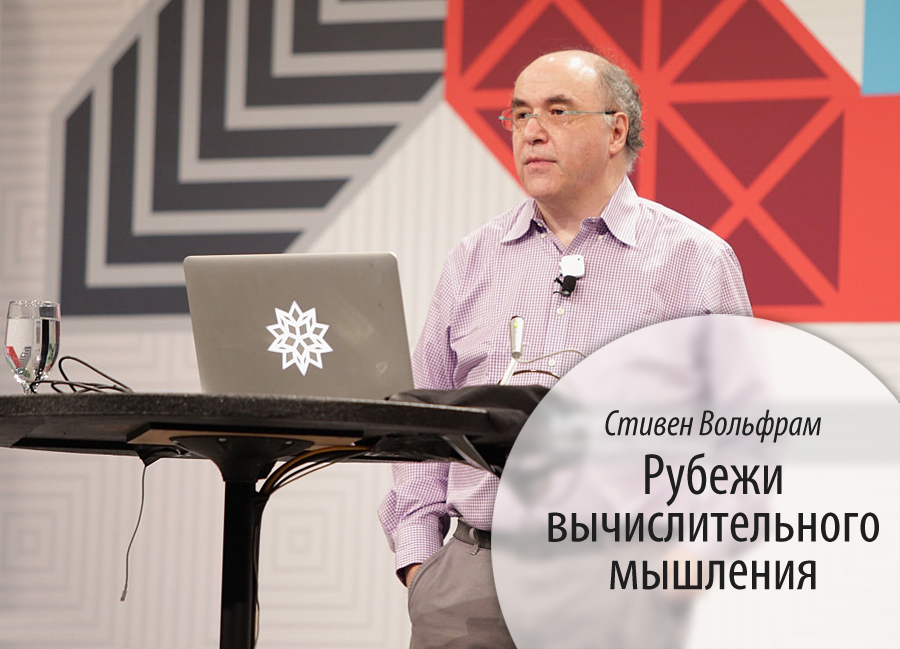
Translation of Stephen Wolfram's post (Stephen Wolfram) " Frontiers of Computational Thinking: A SXSW Report ".
I express my deep gratitude to Kirill Guzenko for his help in translating.
Last week, I spoke at SXSW Interactive 2015 in Austin, Texas. Here is a slightly edited transcript of my speech:
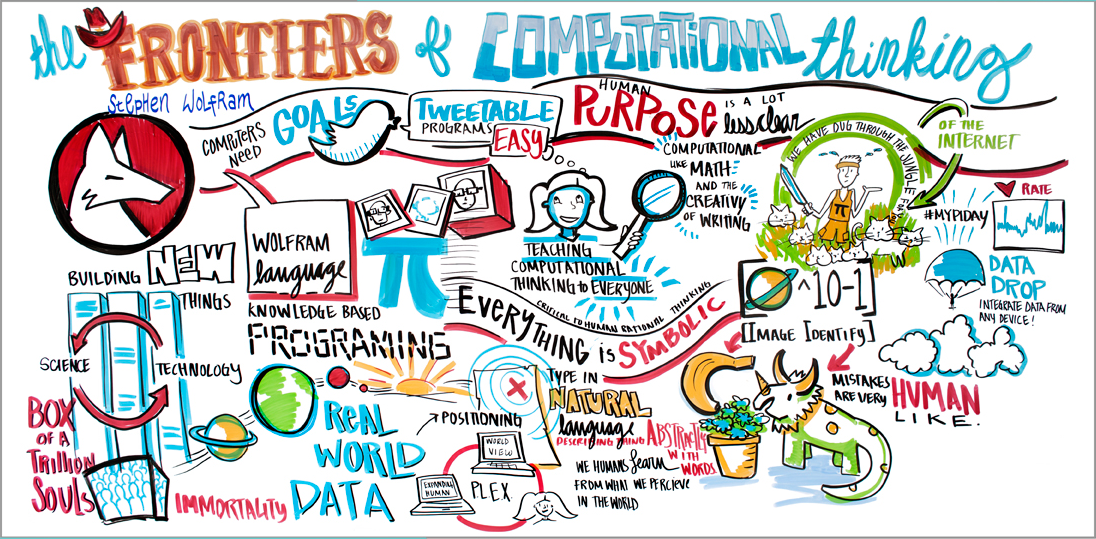
Content
Most productive year
Wolfram Language
Language for the real world
Wolfram Language Philosophy
Programs in the size of one tweet
Computational thinking for children
Entering Requests in Natural Language
Large-Scale Idea: Symbolic Programming
Language for deployment
Programming automation
Large-scale programs
Internet of things
Machine learning
Research Computed Universe
Calculate, just as the brain does
Language as a character representation
Post-linguistic concepts
Ancient history
What will artificial intelligence do?
Immortality and beyond
Box trillion souls
Back to 2015
Most productive year
Hello again! I actually talked about computing three times (" Implementing calculations everywhere " (Habrahabr article), " Talking about the Computational Future at SXSW 2013 ", " Computation and Its Impact on the Future ") here at the SXSW festival. And I must say that when I first agreed to give a speech, I was worried that I could not say anything new. But, in fact, there is a huge amount of new and interesting things. This year has probably become the most productive in my life. And I am glad that I have the opportunity to talk with you here today about some things that I have understood lately.
It will be a fascinating journey in which we will move from concepts and purely practical things to thousands of years of philosophy and from there to cloud technologies and everyday applications.
')
In principle, for the last 40 years I have been creating a “skyscraper” of ideas and technologies that work alternately for basic science and technology . We apply fundamental science in order to build new technologies and technologies in order to further advance in science.
I am pleased to say that many people used both scientific and technological solutions created by our company. But I think that we now have much more than before. In fact, talking to people over the past couple of days on SXSW, I’m really shocked, because perhaps about 3/4 of the people I spoke with would radically change the way we do what they do thanks to the things we created.
Wolfram Language
OK. Now I will tell you how they can succeed. It all starts with the language Wolfram Language . Two years ago, we first spoke about him here on SXSW .
The Wolfram Language is a huge, ambitious project that is at the same time a key technology, repository and implementation of many fundamental ideas . You can start using it right now, for free, on the Internet . In fact, it works almost everywhere: in the cloud, desktops, servers, supercomputers, embedded processors, private clouds, on anything!
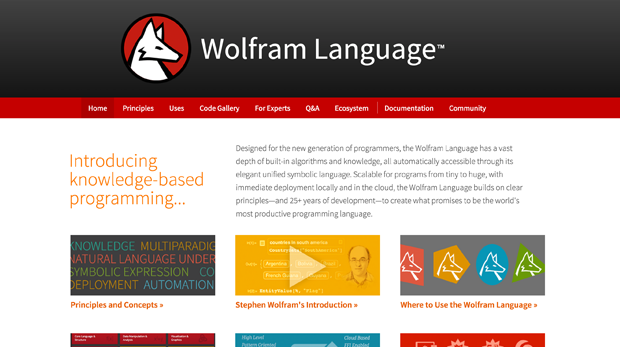
Speaking more abstractly, the purpose of Wolfram Language is to express as much as possible in a computable form, that is, to provide the most common way of encapsulating calculations and data, to automate as much as possible what automation can do.
I worked on the creation of the Wolfram Language for about thirty years. In both Mathematica and Wolfram | Alpha, many people have already used a lot of prototypes of the things that we have now appeared.
But now the Wolfram Language is something else. This is already something more serious. Calculations can be done almost anywhere on anything - any devices, systems - whatever it is.
So let's see it in action. Let's start with a little familiarity with the language in the Mathematica document, which we call the notebook (laptop), which we invented 26 years ago. Let's do something simple.
Good. Let's try something else. You know that this Saturday was the international day of Pi: 3/14/15 (article on Habrahabr " 3/14/15 9:26:53 The celebration of the" Day of Pi "century, as well as the story of how to get your a very personal piece of pi "). And since we are a company that, I think, gave out Pi on demand more than any other in history, we organized a small celebration in honor of Pi. So let the Wolfram Language calculate the Pi number , say, up to 1000 decimal places:
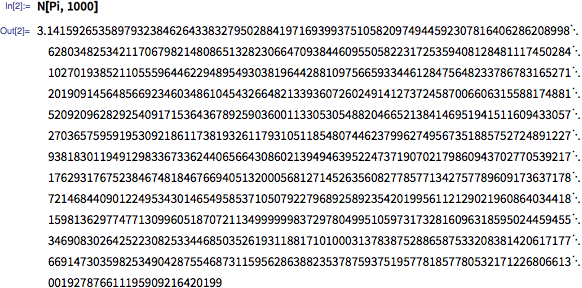
Is done. Why dwell on the small - let's count to within a million characters. It will take a little longer ...

... but not by much. And here is the result. It all goes and goes down ... on the right you can see the scroll bar.
As another example, we can take an article from Wikipedia on Pi:
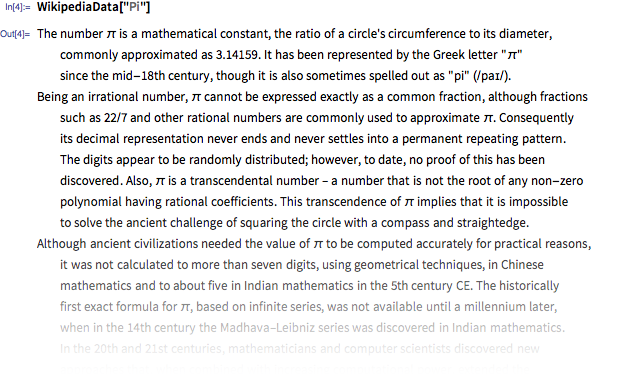
And make it a word cloud:
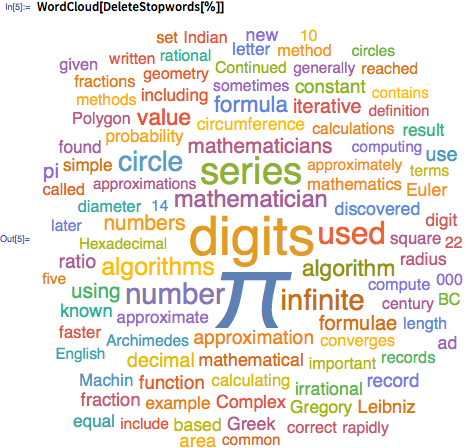
Needless to say, in the article about the number Pi, the number Pi is itself prominently.
Or let's get an image. Here I am:

Let's go ahead and do something with this image. For example, apply the edge search function (EdgeDetect) . The percent sign % always means using the previous result of the calculation, so ...

... here is the result of the search for edges on this image. Or let's make, say, a morphological graph (MorphologicalGraph) from this image, so now we have something like a network:

Oh, here it is already interesting. Or let's automatically create a small user interface where the slider can control the sensitivity of the border search algorithm. Here is what we get:
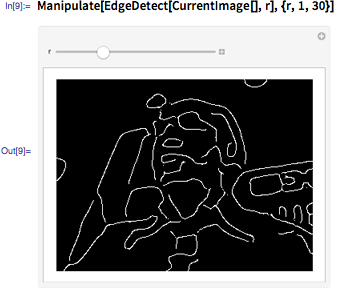
Or we will make a table of images obtained at different values of the sensitivity of the algorithm:

And now, for example, we can put all these images in a pile and get a 3D image :

Language for the real world
The Wolfram Language has a huge number of built-in algorithms . It also has a large amount of factual information from the real world. So, for example, I can simply say “ planets (PlanetData) ”:

The request we gave in natural language was understood and processed. Let's list the planets:

Here, actually, he. Now you can get the images:

And now we find out their masses:

Now make an infographic, displaying images of the planet in proportion to their mass:

I think it's just awesome that a single line of code can produce something like this.
Let's go further. These are the coordinates of the place (Here) , where, as the Internet “believes”, my computer is at the moment (GeoIP):
You can make a request - what time will the sunset be in this place today?

And how much is left of it from the current point in time (Now) ?
Good. Let's make a map (GeoGraphics) 10 miles around the center (Austrian GeoDisk) :

Or, let's say, we get a list containing maps of neighborhoods, the radii of which will be successive powers of 10:

Or let's do the same, but on a global scale. Ask for an Apollo 11 landing site on the moon and build an area with a radius of a thousand miles around:
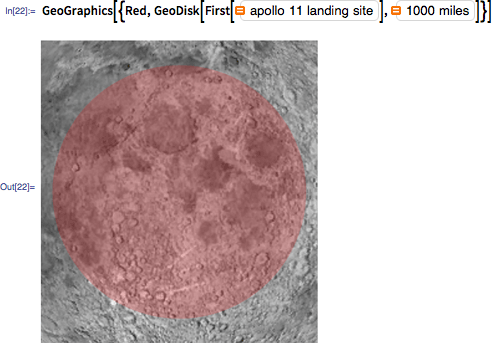
We can do a wide variety of things. Let's try something from another area. For example, we get a list of works by Van Gogh:

And get the images of the first 20 of them:
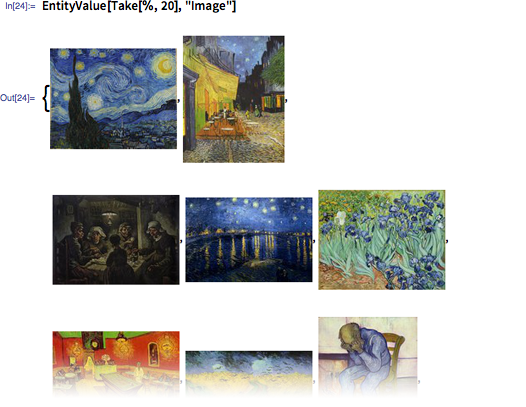
And now, for example, we can recognize the dominant colors (DominantColors) in these paintings:

And build these colors on the color chart (ChromaticityPlot3D) in 3D:
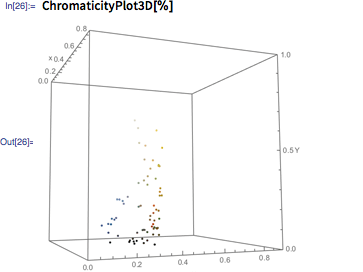
Wolfram Language Philosophy
It is quite surprising how much can be done using such a tiny code on the Wolfram Language.
This is really something new in programming. I mean dramatic changes. The traditional idea is to create a relatively small programming language for writing relatively large programs for some needs. The idea of the Wolfram Language is to make the language as large as possible; embed in it all that is possible; to automate all the processes in programming, which will get hands.
Below are the areas that Wolfram Language deals with:

Now we already have thousands of built-in functions, tens of thousands of models, methods, algorithms, a lot of carefully verified data from thousands of different areas.
I have spent almost 30 years of my life keeping the concept of language clear and consistent.
It was really interesting, and the result is really good, because now we have something incredibly powerful that we can use to develop the language itself at an accelerating pace.
Programs in the size of one tweet
Recently, for the sake of entertainment, we created something called tweets (an article on Habrahabr " Wolfram Research opened the Tweet-a-Program service: interesting programs in the Wolfram Language language, the length of which does not exceed 140 characters ").

The idea is to send the program as a tweet and get the result of its implementation. At our booth at the exhibition (meaning at the SXSW festival - approx. Lane) you can see the gallery of tweets . And here is the online collection of a wide variety of tweets. And most importantly - they all contain no more than 140 characters and do a variety of things:

We decided to mark this case and issue playing cards with codes , each of which contains a tweet:

Computational thinking for children
You know, if you even look at these tweets, it turns out that they are surprisingly easy to understand. You can just read the words and understand how the program works.
You may well assume that even children can handle it. You know, and you will be right! And, in fact, I believe that this is an important point in programming. Consider, for example, what happened with video editing: professionals no longer have any real advantages over children. We have automated our language so much that now there is a similar situation in programming.
Now I am very keen on one idea: to use our language as a way to study computational thinking for the widest possible range of people.
The service Wolfram Programming Lab is coming soon - this is a free internet project. This is something like an intermediate language for learning Wolfram Language, where you have lots of small, working Wolfram Language code snippets. These fragments can somehow be modified, and then run.
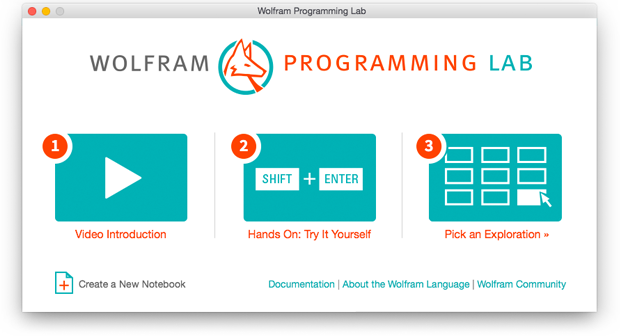
I think this is a very powerful tool in education. After all, this is not just programming training: you can immediately start working with a variety of real materials that are integrated with other things that children learn. This is the way to bring computational thinking to anything.
Let's look at a few examples. Not so long ago there was the day of the number Pi, so let's take a look at the lesson “Necklace of the signs of the number Pi”:

The basic idea is that you have a small working piece of code, and you can modify it, find out what it does, run. You can ask the system what this code does and it will give you an answer.
Consider another example. Let's do something that is more connected with the real world. Say, how far can you look at a particular skyscraper?

The program gives the area of visibility with the Empire State Building. We can go further, change the parameters and see what will change, or go back and deal with other tasks.

I hope that the children (and not only the children) will enjoy what we have done. I think this is great for learning: a certain mixture of exact mathematical and artistic and creative. And, by the way, in the Programming Lab we can look at the programs that users are trying to write, and conduct various kinds of analytics.
It is worth mentioning that soon people who do not know English will be able to see the annotated translation of any Wolfram Language software into many other languages.
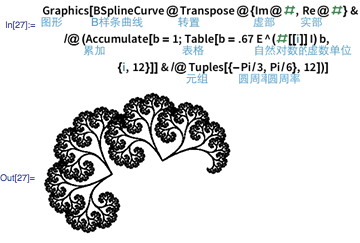
I suppose a lot of amazing things will happen when a much larger number of people master computational thinking with the Wolfram Language.
Entering Requests in Natural Language
Of course, millions of people already use our technology every day, without even realizing it. They simply type a request in Wolfram | Alpha in a natural language, or say something about Siri, which forwards the request to Wolfram | Alpha.
The breakthrough that we have made in understanding natural language has become available both through new types of algorithms and our vast knowledge base .
We use all our knowledge and computing power to create automatic reports on user requests.
Whether questions about demographics:
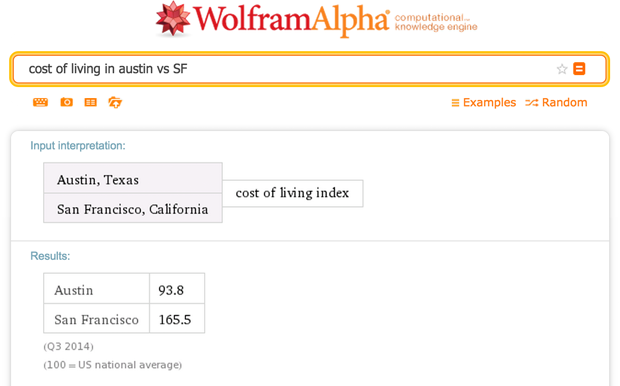
Or about airplanes - the code below shows the airplanes that are above me (that is, above the place where the Internet determined the location of my computer):

Or about genomic sequences. The system will indicate whether this random base-pair sequence will appear somewhere in the human genome:

Above were presented some of the things that can be done in Wolfram | Alpha. And we have already covered thousands of different areas of knowledge , moreover, new ones are constantly being added.
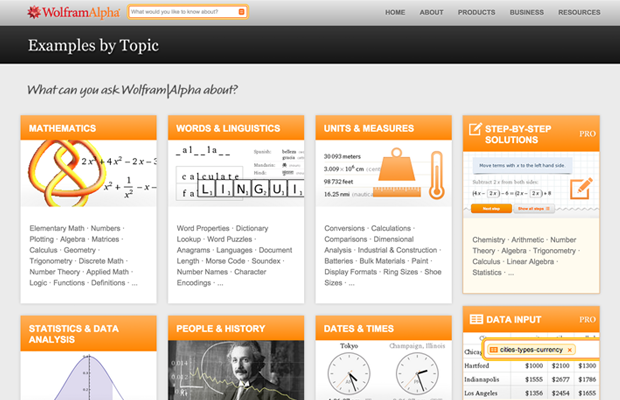
By the way, now there are quite a few large organizations that have their own internal versions of Wolfram | Alpha , containing their own data as well as our public data. And this is really great, because any staff with any level of competence will be able to receive information using requests in natural language, thereby avoiding the need to contact the IT department.
You know, the ability to use natural language is one of the central ideas in the Wolfram Language. Because when you want to refer to something from the real world, say, the city (CityData) - you can't refer to the documentation every time to write down its name. You just want to enter it in natural language and get some calculated interpretation.
And this is exactly what we will do now. Let's introduce, for example, something like:
And we get:
The system interprets this as “New York City”. And now we can, for example, ask about the population of the city:

Large-Scale Idea: Symbolic Programming
There are a lot of things that make Wolfram Language work, and it's not only tens of millions of lines and terabytes of verified data, but also some large-scale ideas.
Perhaps the most ambitious idea of the Wolfram Language is symbolic programming, which was the core of what came to be called the Wolfram Language, and was the core from the very beginning.
Here is the basic concept: in Wolfram Language, absolutely everything is symbolic . And we are talking not only about objects with a specific value. This may be some thing, a concept.
If I just mean x in most programming languages, they will give out something like: “Help, I don't know what x is ”. And the Wolfram Language will simply give out “Okey, x is x ; everything is symbolic. ”
And the point is that almost everything can be presented in a similar form. If I mean “Jupiter”, it’s just something symbolic:

Or, for example, if I add a picture, it will also be a character object:

I may have some kind of slider (Slider) - user interface element - again, it will be perceived as something symbolic:
And now, when you calculate something, you can do anything with anything. You can perform operations with x :
Or with the image of Jupiter:

Or with sliders:

Or with anything.
It took me a long time to understand how powerful this idea really is - the idea of symbolic programming. From year to year I understand it more and more.
Language for deployment
A long time ago, we understood how programs , documents , and interfaces can be presented in symbolic form, so that all of them become things with which you can perform calculations. One of the recent large-scale breakthroughs is an understanding of how to represent not only content and some operations, but also their development.
But let me explain one thing first. Today, during the demonstration, I used mostly the desktop version of Wolfram Language, through which, however, requests can be sent to the cloud to obtain information from our knowledge base and others. Well, having spent a huge amount of man-hours, we received the full version of the entire language in the cloud .
Let me demonstrate this interface - right through a web browser. The workflow is absolutely similar to working with the desktop version, but the calculations are performed in the cloud, and work is done through the browser.
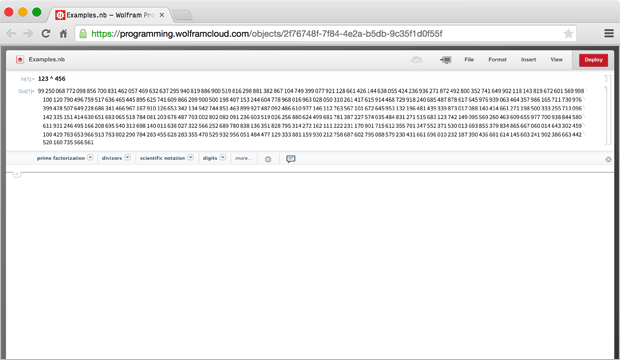
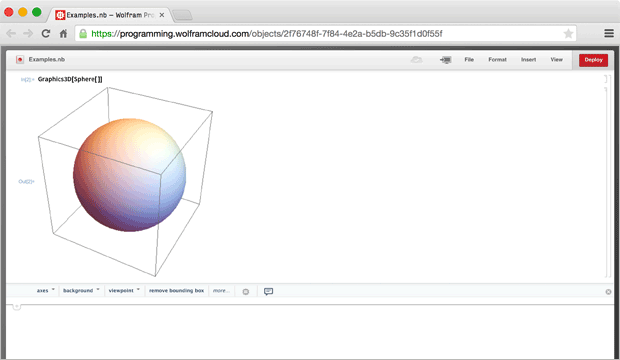

You know, I have forty years of experience in writing programs, and I do not believe that there can be a more insane development environment than the one that works through a web browser in the cloud. It took us a huge amount of effort to get through the jungle of various problems, get the functionality that we want. And we have done well in this. And, of course, the good news is for those people who use what we have done - they will not have to go through all this jungle, because we have already done it for them.
Well, that means we can work with the Wolfram Language right in the cloud. And it is very convenient. But you can also solve other problems through the cloud.
Say, for example, photos with cats - they are very popular on the Internet, so let's make an application about cats. Let's define a form in which there is a field in which you will need to introduce a cat breed, and then we will have to get a photo of a cat of this breed. And then let's put the whole thing in the cloud.
Now we have a cloud object with a URL. We will simply follow the link and see the form. The form contains a “smart field” that recognizes natural language. In our particular case - the description of the cat breeds. Let's print now, for example, “Siamese”. The code will be executed, and we will receive a photo of a cat.
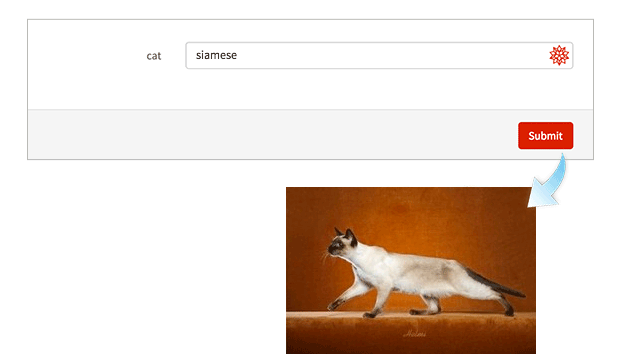
We can make our application a little more complicated. Let's add another field:

Like last time, we lay the whole thing in the cloud, and get a photo of a cat at an angle:
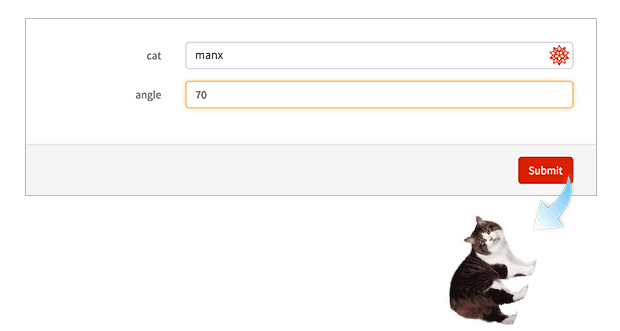
This is actually how we can make a web application that we can use on mobile platforms. We can also do an API for this. We use the same piece of code. In fact, you just need to change the FormFunction to APIFunction in this code:

What we got is a ready-made API, into which we can pass parameters; we can set “cat = manx”, “angle = 300”, run it and get a different result.

The API we just created can be used by anyone through the cloud. And we can call the API from anything: the site, the program, and so on. And we have the ability to automatically generate code in another language to call, say, in Java.
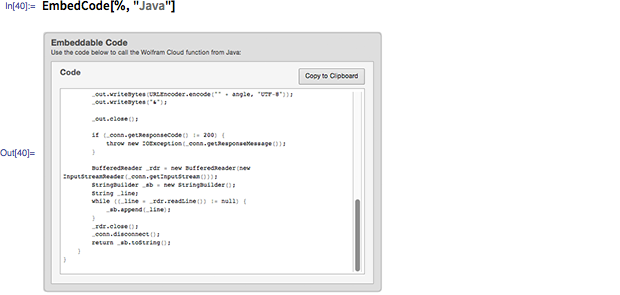
Wolfram Language .
. , . . Wolfram Engine . Wolfram Engine , .
. , , APK Android, .
. , Wolfram Language .
, . , , , … , . , , , , . , 700 .
: , - — , - , -. , , . , !
. — . , , , , .
, . , ? . , :
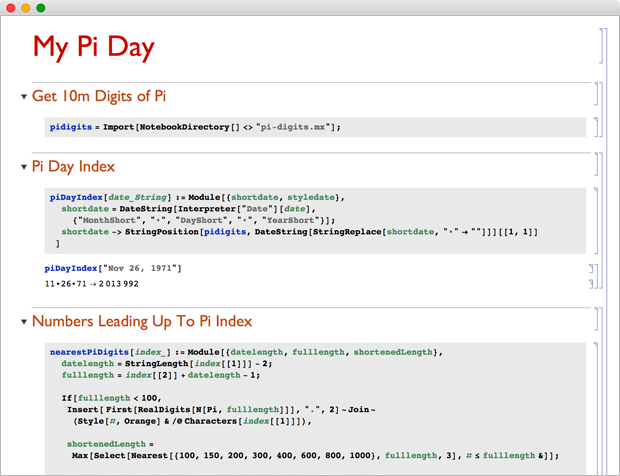
. - , Zazzle API, . , :

- , , . , , , . .

, , . - , .
Wolfram Language — . IDE, Eclipse , Git, . , , , .

— , . ; , , :
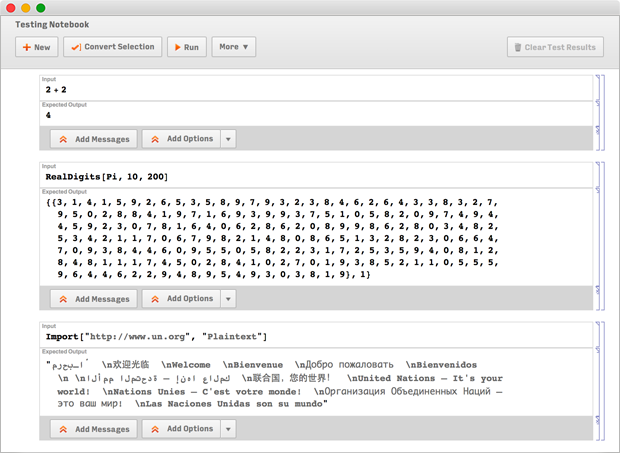
, Wolfram Language / /.
, , — , — , , . « », . / .
Internet of things
, , , Data Drop ( " Wolfram Data Drop — Wolfram Research ").

, — — , Wolfram Language .
, , , - … , , … .

, , wifi . Data Drop, databin , .

WDF — Wolfram Data Framework — , , . .
, , , :

. , , , — , . , , ,
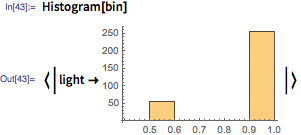
, , . Data Drop , . , Wolfram Language .

Data Drop, , Wolfram Language: Wolfram|Alpha, Siri .
, Wolfram Language , , , databin — . , Wolfram Data Drop — .
, , databin. , , , .
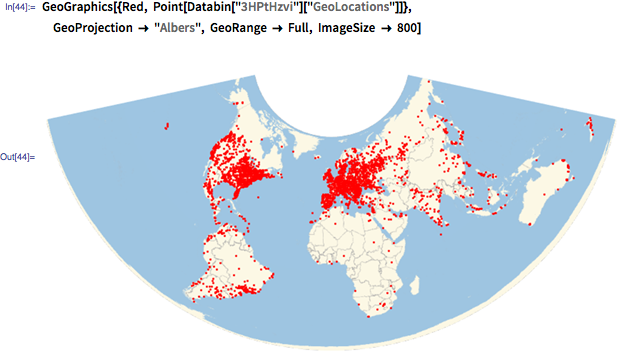
, , , . , , , - . , , 25 , .

— Data Drop — . , databins . databin . , .
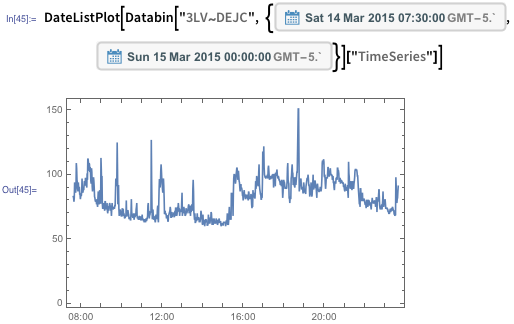
Machine learning
So what do we do with all this incoming data? Well, we have all the power to visualize , classify and analyze data in Wolfram Language. One of our goals is to perform data analysis automatically ( data science ), without taking time from specialists. And one of the areas in which we have worked well for solving these problems is machine learning .
Let's say you want to sort pictures by day / night. Well, here I have a small training set of pictures, which depict either the day or the night. I also have one small built-in function Classify , which will produce a classifier that determines the time of day in the picture.
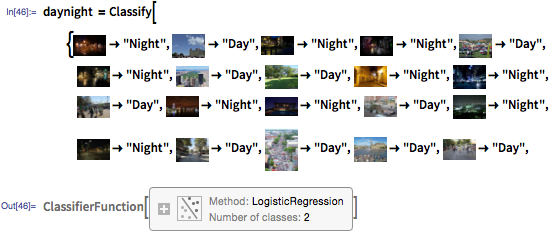
Classifier received. Now I can simply apply this classifier to pictures, and he will tell me where he sees the day, and where the night is.

It automatically determines what type of machine learning is better to use, sets it up, and now you have a classifier that you can immediately use, call through applications, APIs, or whatever it is. And for all this, only one function is needed.
We also have classifiers built in everywhere; And not only they - there are many other equally interesting things. For example, image recognition is something very new. However, I'm going to take a chance and make a live demonstration of some new technologies.
I asked someone to go to Walmart and buy a random bunch of things to try to identify the image. It is very scary and worried. Let's see what happens. So, first install the camera so that you can fully capture images.
So, let's try to recognize this banana. Here, take a picture, and now let's see what happens if I enter ImageIdentify ...

ABOUT! Fine!
That's right. I will continue to tempt fate and try a couple of other things. What is it? Apparently, this is a plastic model of Triceratops. Let's see what the system will say. I hope everything will work out.
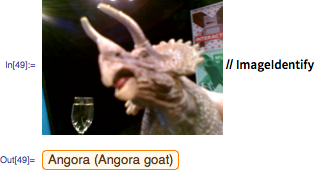
Oh. The system says it is a goat! Well, from that strange perspective, I think I understand why the system decided this.
Ok, let's try one more thing.

Oh wow! Fine! And the plate in the flowerpot says the same thing! This, of course, I did not know. This is impressive!
And all this works fine in most cases. For me, the most interesting is the fact that if the system is wrong, then its errors are similar to those that a person could make. I mean the mistakes that a person could make reasonably.
Actually, what is happening here is quite exciting. You know, 35 years ago, I wanted to understand the design of systems operating on the principle of the brain, studied neural networks, and the like, conducted many computer experiments. Constantly simplifying the rules by which neural networks worked, I gradually came to what is called cellular automata , which are perhaps the simplest programs.
Research Computed Universe
I found that if you look at all these programs, you will find a complete "zoo" of various types of behavior. Here, here are all possible types of cellular automata. Each of them is a specific program with its own behavior.
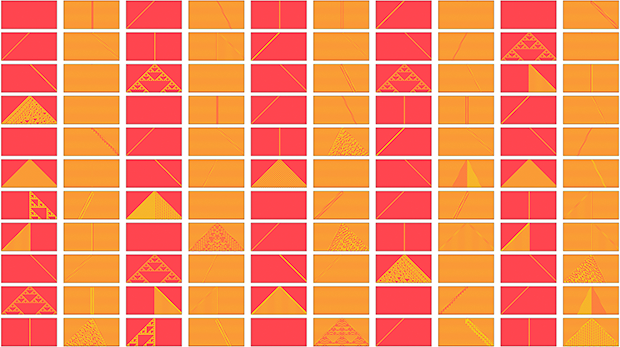
Even if a program is incredibly simple, it can have incredibly complex behavior. This also applies to the example that can be seen below:
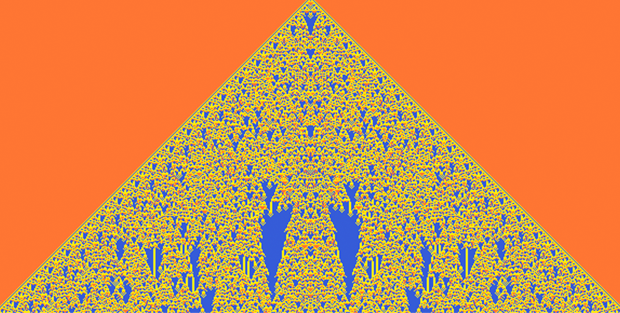
Well, this discovery led me to create a completely new kind of science ( new kind of science ); I wrote the same book a few years ago.
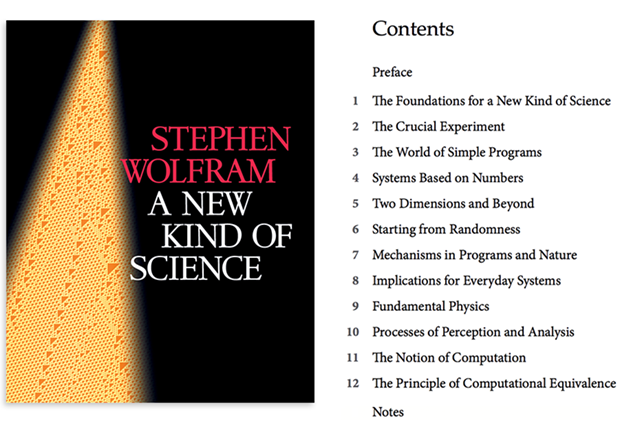
And now there are many applications of cellular automata in various fields . In general, over the past decade, it was possible to observe how the idea of modeling anything through programs has won over the idea of modeling through mathematical equations, which has dominated the exact sciences for the last 300 years.
It is also a remarkable fact that we can make discoveries by exploring and drawing on new things in this world of simple programs. Knowing what we want to get, we can create trillions of programs to find the one that is needed to solve our problem.

This goal may be some kind of artistic exploration , the search for new algorithms in image processing, natural language recognition systems, or whatever.
Calculate, just as the brain does
Well, well, there are really a lot of things that can be created or modeled using simple programs. But people often say that the brain is something special; he must do more than that.
35 years ago, I could create a neural network for use as an attractor or classifier, but I could not get her to do something really interesting. And for many years I could not find any convincing applications of neural networks.
However, quite recently some threshold has been passed. And, as in the image recognizer that I showed, practically the same ideas are used as 35 years ago (in combination with various engineering tricks and a small hint of cellular automata). But what is impressive is that using all these obvious things, combining them with modern technologies, we get what really works.
I could not predict when this was going to happen. However, I am now looking at all this ... it is shocking. We have the ability to use millions of neurons, tens of millions of training images, quadrillions of what can be called analogs of neural impulses. And although the technical details are as different from each other as birds are from airplanes, the orders of magnitude are almost the same as in the case when a person learns to recognize images.
For me, this is the missing link for creating AI. There are so many things in the world with which computer systems can cope much better than humans. For example, if you try to force Wolfram | Alpha to pass the Turing test, you can confidently say that this is not a person - after all, a person cannot know so much and so quickly calculate.
However, there were tasks such as, for example, pattern and image recognition, which we were not able to solve using a computer. But now we can. And, by the way, the way people thought that it would work for 60 years pretty much also works - we just didn’t have such technologies until now to see it.
So, should we now use neural networks everywhere? I think no. The point is this: there are some tasks, such as identifying images that each person learns to do himself, based on what he sees in the world around him and for each solution will be somewhat different.
Language as a character representation
But this is not all that people can do. There is another very important thing, very characteristic of our species. We have a language. We have a way to communicate through symbols, and this allows us to take knowledge acquired by one person, pass it on to other people. And somehow we built our civilization.
So how do we make computers based on the same idea? Well, they must have a language through which you can both describe the world around you and make calculations on it. This is precisely the vector of development of the Wolfram Language; this is what I've been working on for the past 30 years.
You know, all these abstract calculations ... let's take, for example, a cellular automaton, and put it in a calculated universe. But the question is how will it relate to our human world, to all that we know, which is important to us?
Well, what happened was that people tried to reduce things: to describe the world both in symbolic form and with the help of language and language constructs. We explored the world, and then we came up with words to describe it all. We have the word "bird", which refers abstractly to the most diverse types of birds. And now in English there are about 30,000 of the most commonly used words, which are elements of our worldview.
In this vein, it is interesting to compare with the Wolfram Language .
Over thousands of years of evolution of the English language, we have, perhaps, very convenient language structures, but often very confused. In the Wolfram Language, we, and especially me, working for many, many years, kept the structure of the language as logical and consistent as possible. And now we have 5,000 so-called “ keywords ” —functions, and all this together with a large number of other words that describe certain things .
And those things that occurred in the English language implicitly, deliberately implemented by us in the process of developing a language. I look at all these things and processes and try to isolate and define the most general and abstract of them.
You know, this idea with a symbolic representation is perhaps a very important component of human rational thinking. And it is really interesting to realize how the structure of a language influences how people think about things. This effect is slightly noticeable in natural languages, but much more evident in computer languages. And for me, as the creator of the language, it is very exciting to observe the patterns of thinking that open when people begin to really understand the Wolfram Language.
Some people may say, “Why do we use computer languages? Why not just use human natural language? ”Well, let's start with the fact that computers must somehow communicate with each other. But one of the things that I work hard at Wolfram Language, is the creation of such conditions, when not only computers will be comfortable communicating with each other, but also people with computers. Something like a bridge between each other.
Moreover, it turns out that there are things that human natural language, as a result of its evolution, does not so well express. Just think about the programs. There are some programs that can be easily represented by a small piece of text in English, but many programs will actually be inconvenient to express in English. But they are very well expressed in Wolfram Language. So I think we need both languages.
Some things are easier to say in English, some in Wolfram Language.
Post-linguistic concepts
But back to such things as pattern recognition. This is a task that actually goes a little beyond what we are talking about here - about the visual world and creating its symbolic representation, about abstract description using words.
Actually, the task: the neural network has one feature, which is that it implicitly makes differences in concepts, in fact, dividing them into categories.
In the upper layers of the network, these categories are very similar to the categories that we know - those that are used in the early stages of visual processing in humans, and we actually have fairly clear definitions for them: “round”, “pointed”, and so on .
But if you dig deeper, you can find categories for which we do not have certain words. Interestingly, in the course of history, our civilization is gradually introducing new words for any concepts. For example, in the last few decades we started talking about the “fractal structure”. But before that, such tree structures were not defined as something concrete, because we did not have words to describe them.
So our cars will open a lot of categories that our civilization has not yet invented. I gave this concept a rather pretentious name: “post-linguistic emergent concepts”, or PLEC for short. I think we can do some metaconstruction for such things inside the Wolfram Language. But I think that PLECs are part of the way that our computers can build for a truly large-scale expansion of a person’s traditional worldview.
However, before we get to PLEC, we need to resolve some issues in areas that people are well acquainted with. You know, the Wolfram Language contains a lot of knowledge about the world, and we can represent the overwhelming majority of the requests that people send to Wolfram | Alpha, in precise symbolic language. But we still cannot do this with arbitrary human utterances.
So how do we do this? Well, I think we should break them into some kind of “semantic primitives” - the basic structures. Some primitives, such as factual statements, we already have in Wolfram Language. And some, like statements about the state, like “I think” or “I want,” are not contained in ours.
Ancient history
There is one funny moment. For some time I have been working on creating such a symbolic language. And of course, people have already tried to do something like that. But such questions have not been developed since very long time. Thus, in the 13th century, there lived a man named Raimund Llull ( Wikipedia ), who investigated this question; in the 17th century, people like Gottfried Leibniz (article on Habré: " A detailed look at the legacy of Leibniz ") and John Wilkins ( Wikipedia ).
It is rather interesting to see what these people wrote about these their “philosophical languages”. Of course, they did not have that developed basis that we have now. But they were very well versed in ontological concepts. And, looking at what they wrote, you can see what remains and what has changed over the past century. Of course, all their definitions and concepts are terribly obsolete. But much of what they said about a person is still valid, although, of course, they focused on death issues.
And today one of the changes is that we are trying to attribute the concept of personalized internal state to the machine. Not least because, as it happens, the first applications of all this will serve to implement the interaction of people with consumer devices, cars, and whatever.
I could talk about some very relevant technologies that will be available starting next week, to create so-called programmable language interfaces (PLI, Programmable Linguistic Interfaces). But instead let's talk more about the situation in general and about the future.
As I see it, throughout history, people tried to automate as much of what they did as possible through technology. The person defines some goals, and then technology comes into play - in order to automatically achieve these goals as best as possible.
Much of what we are trying to invest in Wolfram Language, in fact, serves to simplify the setting of goals for people. Then we just have to do the calculations, create some external API requests or whatever to achieve these goals.
What will artificial intelligence do?
Without defining the tasks of AI, it turns out that we are already very close to its creation, and in many areas we have gone far beyond the capabilities of the human mind.
But the essence is this: Imagine that we have some kind of a box that stands on our table, and he is able to perform all those intellectual actions that a person can perform. The problem is, what does this box decide to do? He must create for himself some goals and objectives. And the fact is that there are no absolute goals and objectives. Anyone can say: “the goal of life is to make an X ”. But we know that all this is absolutely subjective.
Goals are determined by society, history, civilization. There are many things that people do or want to do today, which would have seemed absolutely inconceivable 300 years ago. It is very entertaining to observe the complex interaction between the progress of technology, the progress in our description of the world — through words and ideas — and the evolution of human goals.
For me, the path of technological development is very clear. The evolution of human goals is that much less clear.
I mean that on the side of technology, more and more of what we do ourselves, but we can also delegate this to machines. We are already transmitting many routine intellectual tasks, like, say, various calculations. Now we are on the way of reassigning machines to such things as memory, and soon to make decisions and judgments.
Some may argue: "We can never entrust creativity to machines." In fact, some aspects of creativity are just the easiest to delegate: we can get inspiration for musical , visual, or any kind of creativity, simply by examining the computational the world, and it's only a matter of time - when will we be able to automatically combine these things with knowledge and judgments about our world.
You know, many of our technology applications in the past were created as needed. But we would like to see technologies that predict what we want to do and offer these solutions.
By the way, I am amused when people start talking about the victory of cars over humanity. It seems to me that everything will develop as follows. It’s just like navigators in cars: most people, including me, just follow what they tell us to do. Similarly, when there is something that says, for example, “you should choose this dish,” or “talk to that person,” in most cases we will simply do what the machine tells us, partly because able to find out and know much more than we do.
, , , . .
, « , », , , .
, . , , . , , . , .
, - — , . , , , . , , , .
, . , , , , . , «», . , , — , , .
. , , -, . , , - — , ImageIdentify , — , . “ ”, . , , , .
, , -, , , , , , , , , , .
, , ? “ ” — . : “, , , , .” , , .
, , - — , (Principle of Computational Equivalence). , . , , . , .
, : , , .
, , , , , . ? , , , «», - , .
2015
, 2015 . , , , , . , Wolfram Language.
, , , , - — - . Wolfram Cloud , , , . , . , , , , .
, , . , , , , . Thank you very much!
Source: https://habr.com/ru/post/255579/
All Articles